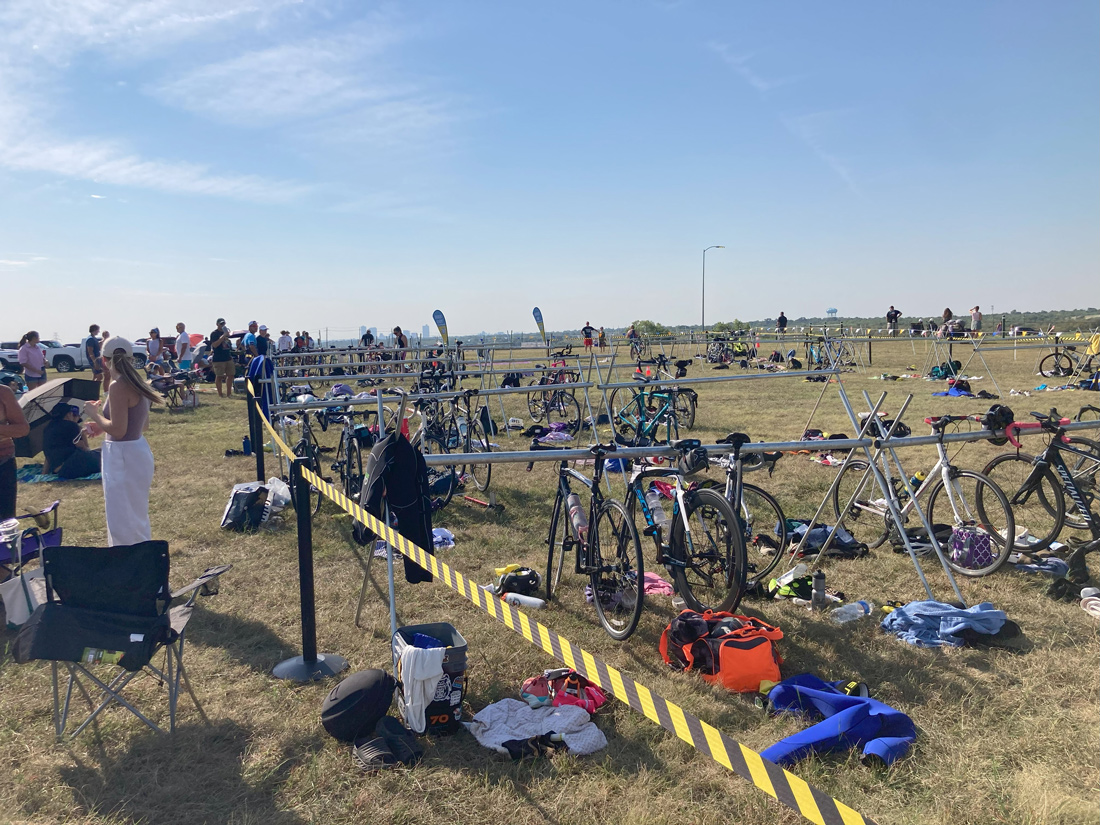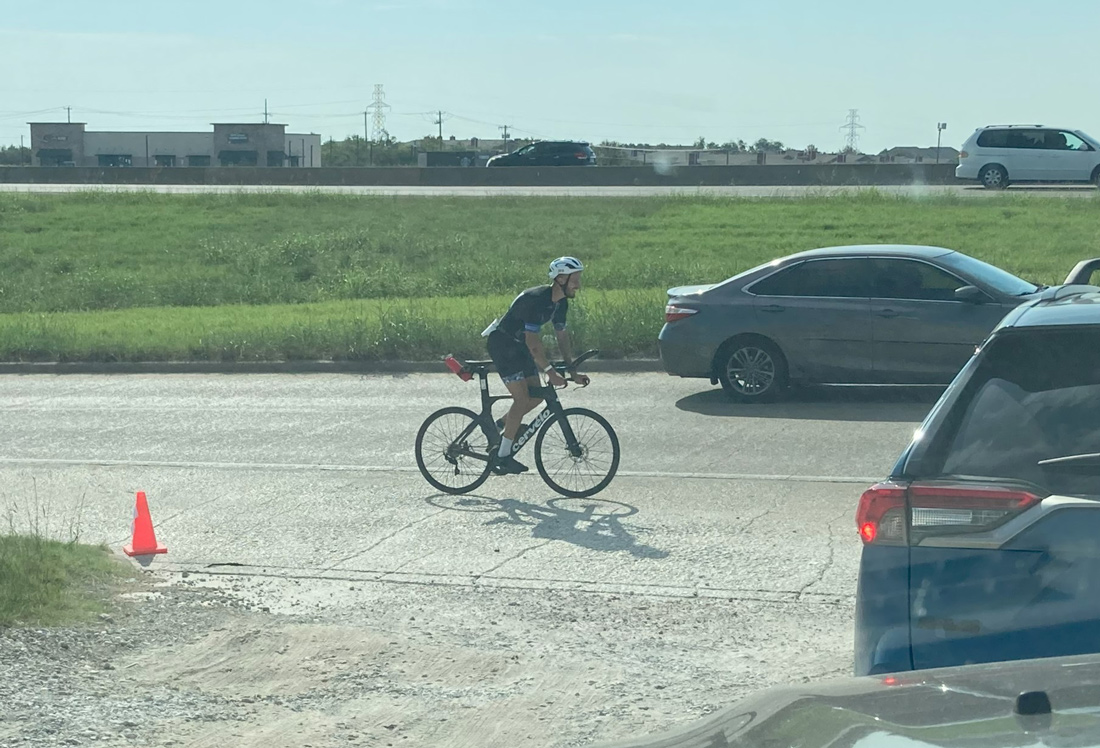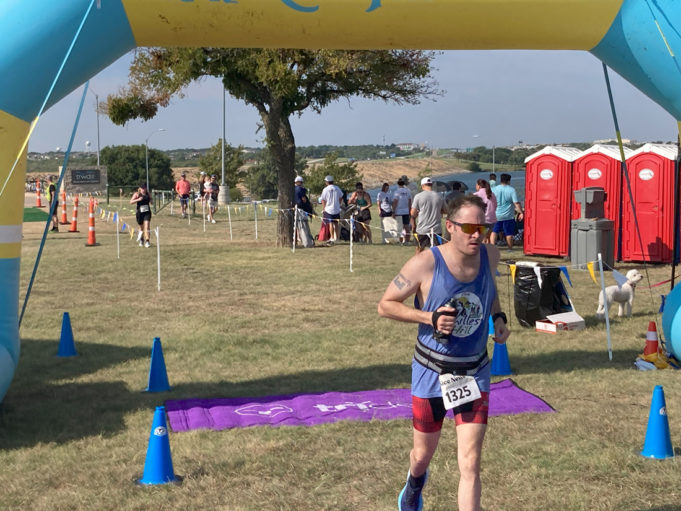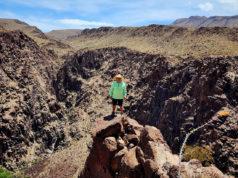The good news about the 2025 Cal Tri Fort Worth is that I finished first in my age group in the sprint race. The bad news is that organizer California Triathlon doesn’t give age group medals, so I didn’t take home any hardware from Marine Creek Lake Park.
A possibly relevant fact is that only one person was in my age group. In fact, at 69, I was the oldest finisher in this particular race by several years, although two 70-year-old guys completed the longer, Olympic-distance event. I am grateful they showed up, because I’m not sure that being the oldest out there is a good thing.
Truth be told, however, aging is central to my race strategy. I figure you can win a couple of different ways. One way is to outswim, outbicycle, and outrun your rivals. Alternatively, you can out-live them, and this has proven the best approach for me.
It’s still a little embarrassing. At my age, a Spandex onesie? There’s also a lot of undignified gasping for air. There’s much sweating. There’s likely staggering as the sun cooks brains in unprotected heads. And that’s just the spectators! The racers are worse.
*****
Seriously, triathlon, if you didn’t know, is an endurance race with three legs. First you swim, then you bike, and finally you run. The sprint is typically the shortest triathlon race, although some events — styled as “rookie” races — are even briefer.
Sprint distances vary. Cal Tri Fort Worth consisted of a 400-yard swim, a 12.8-mile bike on surrounding roads, and a 3.1-mile run on the lakeside concrete path. Olympic distances are approximately twice that long, except the swim leg is a mile.
The sprint is triathlon’s gateway drug. You know how, if you take a single puff off a joint, within weeks you’ll be rappelling from a broken skylight at midnight into a closed drugstore in search of injectable opiates? Same here. People start with sprints, progress to Olympic, then try a half-Ironman, and finally, regrettably, the full Ironman. Twelve-step programs for people who reach this point report mixed success.
With a 2.4-mile open-water swim and 112-mile bike ride followed by a 26.2-mile marathon run, finishing an Ironman is a benchmark of endurance athleticism, a symbol of stick-to-itiveness par excellence. An elite Ironman competitor finishes in around eight hours. Most people are looking at 12 hours.
I have no interest in that or even a three-hour Olympic race. For one thing, my lower limbs can’t take that much running. If I run more than 6 miles at a time, or more than 10 miles a week, soft-tissue injury trails close behind. Then it’s weeks off recuperating followed by a slow and gradual resumption of activity. I dislike all that, so I stick to the race with the 3.1-mile run.

Photo by Mark Henricks
For another, I enjoy activities besides triathlon. Sprint training takes maybe five or six hours a week. Longer distances naturally require more. Ironman prep consumes something like 20 hours a week, or 30 if you are really competitive. We’re talking getting up at 4 a.m. weekdays to run for three hours, then pedaling a century on Saturday, followed by 3,000 yards in the pool on Sunday. Five or so workouts a week like this. For months. Nope!
So, I am a sprinter, but it may not be what it sounds like. It’s a sprint only compared to the longer races. “Slogging” might be the term that comes most naturally to mind at sight of a racer of my caliber progressing down the course.
Triathletes are wild for stats. They endlessly analyze swim minutes per 100 yards, bike miles per hour, and run pace per mile, among other digits. By the numbers, I took one hour, 29 minutes, and 40 seconds to complete this 16.4-mile course. That was good for 23rd out of 76 total participants — officially, that is (more on this later) — about 20 minutes behind first place and an hour ahead of the last finisher.
Per leg, it worked out to 2:16 per 100 yards swimming — again, officially, and again, more later. For some reason, Cal Tri’s results page lacks details on the other legs, but my watch showed I averaged 17.6 mph biking and 10:07-per-mile running. If you know anything about swimming, biking, and running, you know these times won’t get you a sneaker contract.
I can’t blame the weather entirely. At 7 a.m. on that Sunday, when I arrived to pick up my race packet and load bike, helmet, shoes and other gear into the transition area, it was cool, clear, and nearly windless.
This boded well for swimming. Marine Creek Lake showed barely a ripple, in contrast to my usual open-water practice at Lake Granbury. There, the orientation of the swim beach lets prevailing southerly winds whip up impressive chop. A mile of head-butting waves going upwind and spitting out water after every other attempt to breathe going across the wind lacks charm. Downwind has a body-surfing feel under those conditions, but, overall, I prefer still air and flat water.
*****
Standing in line for your packet, arranging your gear just so in the transition area, and, especially, waiting for a portable toilet are all opportunities to converse with fellow triathletes. Everybody’s a little anxious until they get their packets, strap the timing chip to an ankle, place number stickers on bike and helmet, and deposit their gear in transition.
The transition area is where you pile helmet, bike shoes, socks, sunglasses, sweatband, running shoes, hat, race number belt, and whatever else you’ll need next to your bike, which hangs on a rack with hundreds of others. If you’re me, you count rows in from the swim entry to the transition area so you can quickly and reliably find your gear.
Checking out other people’s bikes provides endless entertainment. Some are stone-stock Walmart commuters. Some cost over $20,000 and feature dramatic streamlining and rear wheels consisting of a full disc. They’re chock-full of graphite, Kevlar and similar unobtainium, and weigh less than a saint’s conscience.
I acquired my bike for $750 fourth-hand after it was successively owned by three guys in an Ironman training group. There is no telling how many thousands of miles are on this rig. It got dragged behind my car for some distance when the bike rack failed (operator error may have been involved) and is generally nicked, dented, and worn to a frazzle. Someday I’ll get another, for less than $20,000.
This race allowed a swim warm-up before the 8 a.m. start. I’d driven the bike course the day before and, while I was there, got in a short swim, ride, and run to loosen up after a taper-down week of very light activity. A warm-up sounded good.
I also heard there would be a moment of silence before that. This brings up a macabre aspect to the race. A CrossFit Games competitor a year earlier drowned on this course. Twenty-eight-year-old Lazar Dukic suddenly and inexplicably went under as he approached the finish. By the time anyone noticed and pulled him out, it was too late.
This highlights the fact that the swim leg is the most dangerous part. Triathlon deaths are rare, but, when they happen, it’s usually during the swim. If you cramp up a quarter-mile from shore and one of the lifeguards in kayaks doesn’t notice, things can go bad in a hurry. If it can happen to Dukic, an elite athlete and particularly strong swimmer, it can happen to anybody.
Swims have gotten less dangerous in recent years as races have ended mass starts. Running down the beach at the gun and splashing in with 50 other guys is exciting. It’s also a good way to get kicked in the head, have your goggles knocked off, breathe in a mouthful of water, and otherwise get in trouble. First buoy roundings are often only marginally less congested.
Nowadays, most races do a timed solo start. Swimmers walk to the edge of a dock and jump in one at a time, five seconds apart. This greatly reduces risk.
Also, almost all triathlons take place in this order: swim, bike, then run. The CrossFit racers ran three and a half miles before the half-mile swim. One theory is that Dukic, a Serbian unused to August in Texas, was too dehydrated or otherwise depleted by the time he hit the water to complete the course. His death could be a strong argument for swim first.
I got off to a bad start, jumping in with my goggles still on top of my head. That took a few seconds to clear, and I was off. The ideal conditions enabled what was, for me, a good pace — 1:53 per 100 yards by my watch.
However, swimming in the lake is not swimming in a pool. There’s no line on the bottom to guide you. You have to look up often to see the buoy so you stay on the course. Simple enough and something triathletes practice.
Somehow, I failed to lock on to the bright yellow and blue buoys, each roughly the size of a Kia, delineating the triangular course. As a result, according to my watch, I zigzagged 485 yards instead of 400 yards. Sigh.
*****
The bike began better, with a downhill on the 820 service road to start. The first turn, however, was poorly marked -— almost not marked at all. As I approached it and slowed, another cyclist pulled up alongside and yelled, “Are we turning?” Having previously driven the course, I replied in the affirmative. She passed me, and I noticed a decal reading “Dawn Bauerle” on her front fork.
At the first uphill, I passed the “Dawn Bauerle” rider, then she passed me on the next downhill. I passed her on the following uphill. We continued like this for a few miles until the hills ran out and she pulled away for good, or so it seemed.
All turns except the first were well marked, and I’ve never seen so many police directing race traffic. There must have been dozens of them, which is good since the race ran largely on busy commercial streets, including some under construction with all traffic down to two narrow lanes.
I dreaded the run, mostly because my right Achilles tendon had been aching for a month, and even a week’s total rest hadn’t done away with the throb. I greatly fear tearing an Achilles. I’ve watched more than one rec-league basketball player hobble off the court with that tear, never to return. I was nervous.
It had gotten hot and blazingly sunny by the time I started the run — not ideal conditions. Still, I felt good the first quarter-mile, which was all downhill. This lasted through some gentle ups and downs to the aid station a mile out. There I walked a few steps while gulping some water, not far behind a runner in a green and black tri suit whom I’d noticed earlier.
I followed this runner to the turnaround at 1.55 miles, gradually catching up. By the time I finally passed her on the last climb to the finish, she was walking, and I was struggling as well. Twenty yards to the finish, I fought down a sudden surge of nausea. Once through the finish arch, I stripped off my timing chip and stood hands on knees, more or less completely spent and debating whether I would be universally scorned if I threw up right there.

Photo by Mark Henricks
*****
A few minutes and a cold can of Sprite raised my spirits, and I struck up a conversation with Anthony, a tall Fort Worthian doing his first triathlon with an eye on a half-Ironman before long. He was annoyed by a rookie mistake — starting too fast. No matter how careful you are not to do this, it’s nearly irresistible to come out too hot on the swim.
By the time Anthony got to the first buoy, only 100 yards or so in, he said he was struggling to get enough air in his lungs. He had to slowly breaststroke for half a minute to recover, and by then, he was thoroughly disgusted with his performance — only a few minutes in! — and frustrated by the whole thing.
I, a grizzled veteran of 15 or so races, counseled him that this was a common problem, probably caused by competitive adrenalin. After a few races, he’d calm down, strategize, and conserve energy. My favored approach is to start slow, then taper off, but I felt this might be an overly sophisticated insight for a neophyte, so I didn’t mention it.
Pushing my bike back to the truck after the brief awards ceremony, I ran into Vladimir, also of Fort Worth. He’d finished fifth overall, just out of the medals, after being passed toward the end of the bike by a couple of guys going even faster than his spanking 25-mph pace. We commiserated over the fact that triathlon favors bikers over swimmers and runners, while I privately wondered what performance-enhancing drugs let people pedal that fast.
By then, I’d looked up the results online. This informed me, among other things, that Dawn Bauerle was the actual name of the racer I’d dueled with over much of the course. She was also the green-and-black-clad runner I squeaked by at the end. Interesting fact: She was the second-oldest sprint racer, at 61. She also finished third overall among all females — a striking accomplishment for the senior woman.
*****
I’ll take this opportunity to set the record straight: Dawn also beat me, by 21 seconds, according to chip time. For reasons best known to the company that compiled the results, she was listed as finishing just behind me and in fact crossed the finish lane after I did. But chip time is what counts. So, props to you, Dawn! A nice race. (And I was 23rd only officially.)
As is often the case, there were points in the last mile of the run when I could not recall why I got into this sport. (The reason is that after 20 years of basketball, I was tired of being an average player on a good day, tried something new, and found I was better at endurance sports.) But then, I crossed the finish, caught my breath, and began looking forward to an afternoon on the couch watching football.
Overall, the best news about Cal Tri Fort Worth 2025 is that I escaped injury and did minimal walking, coasting, and doggy-paddling. I occupied my usual spot toward the front of the middle of the pack. I’m even starting to look ahead to the next one. Cal Tri hasn’t given a date for Fort Worth 2026, but whenever it is, I plan to be a year older — and still in the race.











